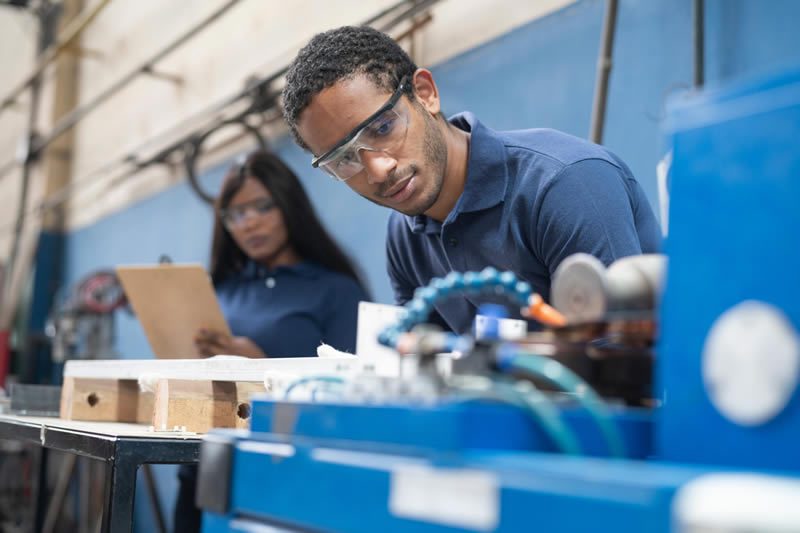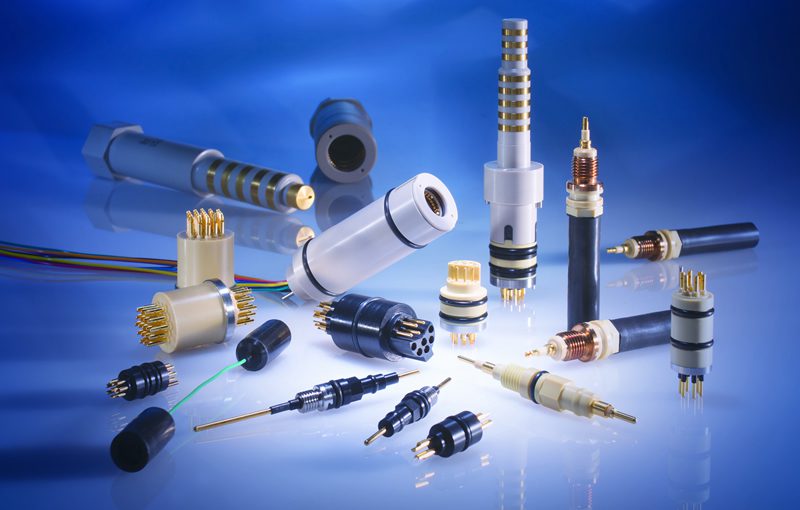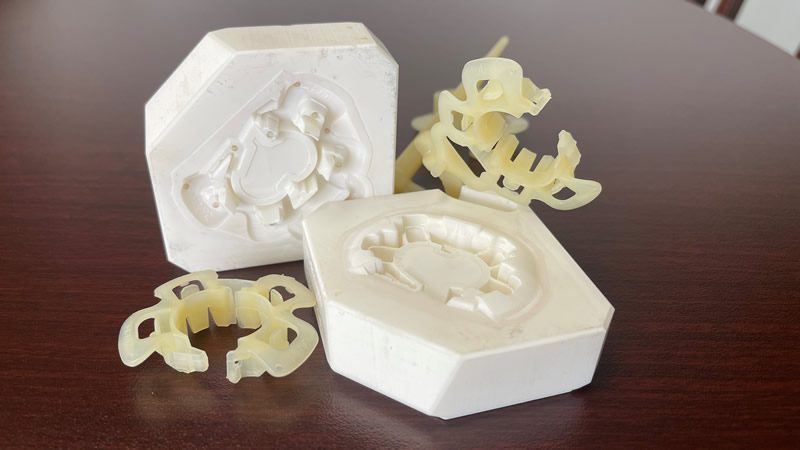Building Better Connector Prototypes
Because the electronics market moves so quickly, any opportunity to eliminate delays in the production process is crucial. Significantly speeding up the development of prototypes for testing, qualification, and, ultimately, production is a huge advantage for parts suppliers and their customers.

Quick Design for Connector Prototypes
Customers’ needs for connector prototypes continue to evolve. To stay competitive and aligned with industry requirements, manufacturing processes have had to advance as well. Typically, connector components are last to be specified within the system. Electrical and fiber optic connector attributes, such as number of signals, outer size dimensions, and power requirements, are not determined until the entire system is fully designed and often can change throughout the design qualification process. Despite these constraints, customers require a functional and reliable prototype in a tight timeline.
A popular method for quick-turn connector prototypes was to develop stereolithography (SLA) models to establish form and fit which lacked functionality. This method has been developed into modern day 3D-printing methods. Currently, the form and fit quality of the 3D-printed prototype has greatly improved, but functionality remains a challenge particularly when dealing with highly engineered plastics. Around the connector industry, significant investment and development time is being spent on 3D-printed PEEK components, but the challenge remains of printing a functional, complex PEEK connector around the inner metallic components.
Traditionally, custom connectors would be machined out of rod stock shapes for prototyping and then injection molded for qualification parts. Some issues with this approach are the variations that can arise between dimensions and tolerances from machined to molded designs. Making these adjustments after prototyping can add significant production time to the process. The preferred method is to develop qualification parts from a molded condition from the beginning of the product development process. The challenge with this method is the time and cost required to develop mold tooling as well as manage tooling changes throughout the qualification process.
Garry MacDonald, Seal-Connect platform manager at Greene Tweed, explained that Greene Tweed’s customers want to qualify connectors quickly, so they need form, fit, and function in the prototype (first build) systems. “The cost of qualification is high, so they want those connectors to be essentially production-level right off the bat,” he said. “Once the part is qualified, no changes can be made in processes, design, and, in some cases, even the location where the parts are being manufactured. That forces us to develop and produce a ready-to-be-qualified, full production part right at the start.”
These parts used to require 16 to 20 weeks to produce, but today’s customers have a window for this process of, at most, six to eight weeks. Suppliers like Greene Tweed have had to evaluate and streamline their production processes to meet this demand. The first thing that had to be done was to bring dedicated resources of people, machines, and materials to the product development process. By making this change, the priority for prototypes shifted to prioritize efficiency.
Greene Tweed develops full mold tools, which means a lot of work must get done in six weeks. Design work in the form of models and overall drawings is done up front for collaborating with the customer and preparation of the quote. Once the part is designed and a purchase order for the prototypes is received, the real work begins. “That includes all the detailed drawings, adding the part numbers into our system, doing a design for manufacturing review, designing the mold tool, manufacturing the mold tool, and then actually molding and machining the parts along with procurement of the metal materials (the pins and sockets that we use). We sit our metal components in the mold tool, then we injection mold the plastic material in and it either comes out of that in a final shape, or in many cases, it comes out as what we call a molded blank. Then we machine in the features that we need to get the final part,” MacDonald said.

Greene Tweed’s Seal-Connect line of connectors are pressure-rated in extreme conditions and outperform traditional glass to metal connectors.
To keep up with customer expectations, Greene Tweed’s Seal-Connect team deployed Lean Six Sigma methods to the new product development process. In 2019, they completely tore the process apart to identify waste and increase efficiency.
Greene Tweed made many significant changes to accomplish this. “We started to set an expectation for service level among the many functions who touch the process. When our tooling designers get a request from engineering, they have to turn around the design in a couple of days,” said MacDonald.
Greene Tweed instituted a default-make strategy and invested in machines, raw materials, and everything needed to make connector prototypes internally. Components that are outsourced at the production level can now be produced in-house for prototyping. Once the parts are built a couple of times and considered in production, the team will use suppliers for some of those parts. Additionally, Greene Tweed has the capability to qualify their designs in-house to aid in expediting customer proof of concept and qualification which allows more efficient collaboration with their customers.
After qualification, customers sometimes require changes or adjustments to the prototype design. In some cases, Greene Tweed can make those tool safe adjustments as required, otherwise a new mold tool is needed. Although the process starts over, the tooling designs are usually close enough to get the final production tooling in same 6 to 8 week timeframe.
Another process adjustment was creating a forward scheduling operation. Often, a production schedule is created by working backwards from the due date, but in product development there can be unknowns, so that scheduling doesn’t work for developing prototypes. “We flip that around and start working on it as soon as the kickoff meeting happens. We start making tools and components to be able to mold connectors right away,” MacDonald said. “This allows us to make adjustments during development with time to spare to hit the customer’s delivery requirement.”
3D Printing + Injection Molding for Prototyping Interconnects
The use of 3D printing to build fully functional parts is still a ways off. However, it is a cost-effective and time-saving option for creating the mold cavities used to make parts in small quantities at the development stage. Amphenol Pcd’s Rapid Part Development (RPD) process combines 3D printing and injection molding to produce parts specifically for the aircraft industry, including North American commercial OEMs and the bigger eVTOL OEMs.
Mathieu Desjardins leads the team of four engineers at Amphenol Pcd that has been developing RPD to meet the needs of customers initially requiring two or three shipsets worth of custom parts. Even though the higher production volumes won’t come for two to five years, the smaller initial runs still require production-level tooling. Typical injection molding requires a steel mold that is costly and time-consuming to create, making it impractical for those initial small quantities of custom parts. “One of our main objectives for developing this process was to eliminate the initial need for a steel tool. We 3D print the cavities, essentially a mold insert, with commercially available printers using SLA or digital light processing (DLP) technologies. We fit these cavities into a regular 40-ton injection molding press. It’s the same equipment that we would use for full production volumes or regular injection molding,” Desjardins said.
These cavities are used to mold the same materials (nylon, Ultem, and PEEK, including glass-filled grades) that are already in use on aircraft and certified with all their customers. “That lets us produce production-quality, end-use parts in a 50-200 part range in a three- to four-week timeframe. The tooling cost is significantly less, which eliminates the hurdles of lead time and the initial NRE [non-recurring expenditures] required. Once the production quantities ramp up, the economics make more sense to invest in a regular steel mold,” said Desjardins.

Amphenol Pcd’s Rapid Part Development process combines 3D printing and injection molding to produce cable and pipe supports (clamp blocks, D clamps, clips) for wiring bundles, busbars, and hydraulic tubing.
Connector suppliers continue to streamline the process of building connector prototypes, making it faster and more cost-effective for customers to create new product designs. This makes a huge difference for applications such as eVTOL that have lots of players continually developing new designs.
To learn more about the companies mentioned in this article, visit the Preferred Supplier pages for Greene Tweed and Amphenol Pcd.
Like this article? Check out our other Custom and Manufacturing articles, our Special Topics Page, and our 2023 and 2022 Article Archives.
Subscribe to our weekly e-newsletters, follow us on LinkedIn, Twitter, and Facebook, and check out our eBook archives for more applicable, expert-informed connectivity content.
- Sealing Success: Overmolding for More Secure Connections - April 23, 2024
- Medical Cable Assemblies Product Roundup - April 23, 2024
- Mezzanine Connectors Product Roundup - April 16, 2024

